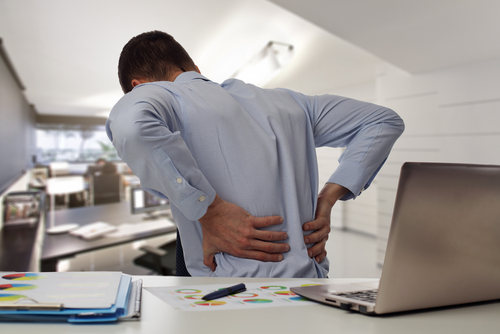What Aggravates SI Joint Pain?

Do you experience lower back pain?
Have you ever stepped awkwardly and then experienced pain in your legs Your sacroiliac (SI) joint could be the cause of your pain!
The sacroiliac joint or SI joint is the connection point between the sacrum and the ilium. The sacrum is the triangular bone at the base of the lumbar spine and the iliums are attached to each side of the sacrum. The iliums and sacrum together make up the pelvic complex.
It is estimated that the SI joint accounts for 15-30% of low back pain cases. When the SI joint is the cause of pain, it’s called a sacroiliac joint dysfunction (SIJD) – when one or both of the joints is not working properly or is injured. Research shows that an SIJD will lead to a number of other musculoskeletal problems. To understand how that occurs we first need to understand how the SI joint works.
There are many thick, dense ligaments and muscles that connect the pelvic structures. These ligaments and muscles give us the ability to move. The hip joints have a larger range of motion while the SI joints have just a few degrees, very small in comparison.
This few degrees of movement is very important for the health, balance and function of your musculoskeletal system in regards to movement. The SI joints play a large role in your ability to walk and run.
Here’s how it works:
The sacrum moves through what is called nutation and counter nutation. Nutation is when the sacral base (the top that connects to the 5th lumbar) tilts forward. Counter nutation is when it tips backward.
Not only can the entire bone tilt forward and backward but when we walk or run, one side will nutate and the other will counter nutate.
For example: when you take a step forward with your right leg, the right side of the SI joint will nutate (dip down and forward) while the left side will counter nutate (rise up and backwards). This movement happens tens of thousands of times per day, not only with walking, but breathing as well.
When one SI joint is injured or not working properly, a problem arises. The body will try to protect the joint from further damage by inhibiting the muscles that cause nutation and activating the muscles that cause counter nutation.
A pelvis out of alignment can’t move properly. If the joint is stuck, it can’t flex and extend as you move. This causes a pelvic dysfunction over time. Not only will the pelvis become out of alignment (unbalanced), but the entire complex will not oscillate properly as you walk or run.
How does this happen?
Trauma to an SI joint can result from a number of different causes. Sometimes these are serious injuries from events like a car accident or fall onto the buttocks, but sometimes small or repetitive forces that weaken the ligaments around the SI joint.
A few major causes of SI joint injury include:
- Missing a step or landing on one foot
- Repetitive rotational movements like golfing, bowling, batting, throwing, etc., and axial loading of the spine (Axial loading is when the spine is loaded with weight and the compressive forces transfer down through the spine into the sacrum and SI joints causing the joints to nutate. This is common with weight lifters and body builders)
How do I know if I have an SI joint dysfunction?
The only way to be certain if you have an SI joint dysfunction is with a detailed examination and consultation.
However, some of the common secondary conditions that result from an SI joint dysfunction are pain in the low back, buttock, hip and/or groin.
The pain may be worse when sitting with the legs crossed, bending forward, and even extending backwards. Sometimes the pain may be felt as stiffness, achiness, burning or numbness and it may travel down the leg.
Call Pivotal Chiropractic for SI Joint Pain Relief
There are several noninvasive treatment options if you’re living with SI join pain. The goal is to return the SI joint to normal function. For more serious or chronic cases, you should see a chiropractor for further treatment.
Don’t risk nerve damage by ignoring SI joint pain! Our goal is to make the correction you need to get relief, and most importantly: make sure your body holds the correction. By correcting the structure of the spine, it will relieve pressure on the discs, nerves and joints that are causing you specific secondary condition.
To schedule a complimentary consultation where a conversation is never a commitment, you can contact us at 734-221-0362.


